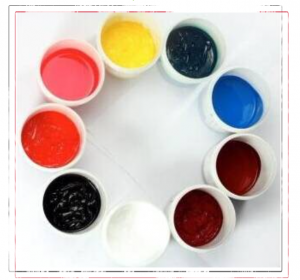Infrared reflective color paste
With concerns about the heat island effect in large cities and the need to reduce energy consumption, there is a growing interest in colorants that reflect infrared light to reduce heat buildup in materials. In addition, many countries are beginning to develop regulations that require the use of “cold” coatings to reduce energy consumption. To meet these new requirements, paint formulators are looking for raw materials to support their research and development.

We know that sunlight is the main source of infrared energy. When these light waves are absorbed by any outdoor surface, the surface becomes hotter and hotter. On black surfaces, it can get even hotter enough to burn the skin. During the highest temperature hours of the hot summer sun, black tarmac is hot because dark surfaces cannot reflect the energy from the sun’s infrared rays away. In addition, this effect also leads to higher room temperatures in buildings with dark roofs. In buildings that are not equipped with air conditioning, high indoor temperatures can be dangerous. The use of air conditioning to reduce indoor temperatures can increase costs.
The use of infrared reflective pigments in coatings is a way to reflect infrared energy from the surface of the coating into the atmosphere. This can reduce the surface temperature. While roof coatings are where these pigments are used, there are other applications where infrared reflective pigments would be beneficial to people and the environment. This article provides an overview of the technology and uses of infrared reflective pastes.

Total Solar Radiation
The sun’s radiant energy consists of about 3% ultraviolet (UV) light, 44% visible light and 53% infrared light. Most of the energy from UV is absorbed by the atmosphere. In addition, the atmosphere scatters a large amount of the blue light waves from visible light, which is why the sky appears blue. However, most of the energy from infrared light reaches the Earth’s surface, and infrared light generates heat. Near-infrared light (about 700-2500 nm) contains most of the heat energy produced by sunlight. Figure 1 gives a map of the solar radiation spectrum, including solar radiation in the upper atmosphere, and the distribution of ultraviolet, visible and infrared energy in solar radiation at the Earth’s surface.
Solar radiant energy is usually absorbed by the Earth during the day and transmitted back to space at night in the form of radiation. Of the solar radiant energy that reaches the Earth’s atmosphere, about 23% is absorbed by the atmosphere, 31% is radiated back into space, and 46% is absorbed by the Earth’s surface. The Earth’s surface radiates the absorbed solar radiant energy back to space, through heat exchange in the form of long-wave radiation, latent heat and sensible heat.
When the input and output radiation are in equilibrium, there is no change in the overall temperature of the Earth’s surface. However, because the Earth’s surface is covered with heat-absorbing materials such as black roofs, coated concrete, asphalt or other dark surfaces, the balance of input and output radiant energy can change.

Offsetting absorbed infrared radiation
To counteract the effects of absorbed infrared radiation, coatings reflect infrared light from the coated surface back into the atmosphere. Infrared reflective coatings can be formulated with a variety of pigments, metals (such as aluminum) or other raw materials to form an infrared reflective barrier layer. These raw materials reflect the near-infrared region of the spectrum where the most heat is generated. As a result of reflecting these infrared rays, a surface coated with an infrared reflective coating will have a lower temperature compared to a surface with a conventional coating.
One way to understand how this concept works is to consider why white appears in the visible region. Because white reflects all wavelengths in the visible spectrum, the color will appear white to the human eye. In fact, titanium dioxide, a raw material used in most white paints, reflects infrared radiation as well as visible light radiation. Conversely, materials that do not reflect visible light will appear black. Carbon black also absorbs most of the infrared wavelengths and therefore becomes hotter than most other colors. If we could see the color of the material as it appears in the infrared wavelength range, coatings that reflect all infrared wavelengths would also appear white. Figure 3 depicts this phenomenon by showing a gray color formulated with a non-IR reflective pigment such as carbon black and an IR reflective pigment in the visible and IR regions, respectively.
When it comes to coloring surfaces, there is a desire for more options, and for many applications white coatings are not suitable. There are now numerous coloring materials that offer a wide range of colors as well as reflect infrared wavelengths. These materials have been formulated by Chromaflo Technologies into liquid dispersions, making them easy to use by coating formulators.
Color Selection Using IR Reflective Colorants
When determining color options and infrared reflectance coefficients, the total solar reflectance (TSR) of the material needs to be considered. TSR is the amount of solar radiation energy, expressed as a percentage, that is reflected off the surface of the material. At higher TSR values, the surface will absorb less solar radiant energy and thus have a lower surface temperature. The change in temperature is measured in degrees and is called Heat Build. White coatings have a TSR value of about 75%. The reason for this is that titanium dioxide reflects more than 90% of the infrared light between about 700-1300 nm and about 30% of the wavelengths between about 2500 nm. Carbon black coatings have a TSR value of about 5-10%. The range of TSR values for coloring materials used in coatings is about 25% to 70%. Mixing any IR reflective colorant will change the TSR value of the pure colorant. Therefore, for finalizing the target TSR value of a color, the correct choice of color paste is very important for a specific color space.
This technology is currently used for roof coatings, exterior building coatings, and wood (window and door) coatings. The purpose of these applications is often focused on reducing the heat absorbed by the building surface in an effort to reduce the energy costs used to cool the interior space of the building and protect the substrate from high temperatures. These techniques will also be applicable to other surface coatings such as those used on outdoor tanks, playground equipment, pool decks, concrete surfaces, automotive interior parts and theme parks. In short, any outdoor surface coating that can benefit from a reduction in surface temperature will be an application for infrared reflective coatings.
Solvent-based and water-based formulations
Specially designed solvent-borne and water-borne infrared reflective pastes have a wide range of compatibility with coatings. An example of a solvent-based infrared reflective color paste is the Spartacryl PM® series, which can be formulated into a universal color paste system for coating formulators for tinting and full tinting of most solvent-based industrial coatings. There is also a solvent-based, low VOC color paste in Chroma-CHEM® 846. These pigments provide a wide color space, excellent durability, lightfastness and chemical resistance, dispersed in a unique proprietary acrylic resin base that provides excellent wetting and dispersion. The solvent used is a variable mixture of proprietary esters and propylene glycol monomethyl ether acetate.
Examples of aqueous infrared reflective color pastes are Chroma-Chem 50-990 series and 897 series. The former is a low VOC pigment dispersion that consists of finely ground pigments dispersed in a blend of water, additives and a unique low VOC lacquer base. The combination yields color pastes and waterborne products with a wide range of compatibility. To better meet current VOC regulations, these pastes contain no added VOCs and are glycol-free. 897 products are high tint strength, low VOC pastes designed for use in a variety of waterborne industrial coatings. These pigments provide excellent durability, lightfastness, chemical resistance, and are APE free.

